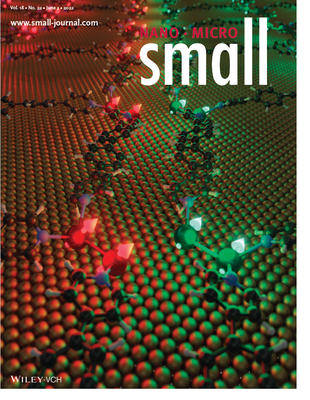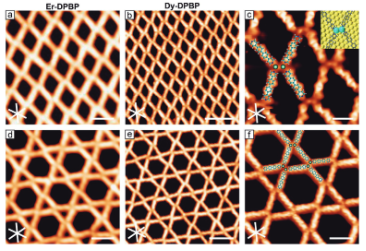Do you want to keep up to date? Subscribe to our newsletter. 1mail every 2months! |
 |
 Cerdanyola del Vallès, 10th June 2022 Single molecule magnets (SMM) based on lanthanides have been intensively studied in the last few years aiming at the stabilization of magnetic moments at the molecular level and the development of higher density storage applications. In fact, lanthanides offer a set of properties that are suited for this application: they possess high magnetic moment that is well protected from the local environment thanks to 4f-orbital localization, and they can have a bistable ground state allowing for a single-atom magnetic state with slow relaxation time. Developing a way to organize SMM’s in ordered and periodic networks on surfaces is of crucial importance to design surface-supported architectures with defined and reproducible properties.
Cerdanyola del Vallès, 10th June 2022 Single molecule magnets (SMM) based on lanthanides have been intensively studied in the last few years aiming at the stabilization of magnetic moments at the molecular level and the development of higher density storage applications. In fact, lanthanides offer a set of properties that are suited for this application: they possess high magnetic moment that is well protected from the local environment thanks to 4f-orbital localization, and they can have a bistable ground state allowing for a single-atom magnetic state with slow relaxation time. Developing a way to organize SMM’s in ordered and periodic networks on surfaces is of crucial importance to design surface-supported architectures with defined and reproducible properties.
Organic molecules offer a pathway to realize such networks via coordination with the metallic atoms and have been demonstrated in the past years as building blocks for ordered metallosupramolecular architectures. However, metal-organic architectures based on lanthanide atoms are still scarce and multi-nuclear lanthanide coordinative networks are unexplored.
In the study published on the journal Small, a group of researchers led by prof. David Ecija from the IMDEA Institute in Madrid, and realized in collaboration with staff from the ALBA Synchrotron, has demonstrated for the first time the realization of a di-nuclear all-lanthanide ordered supramolecular architectures supported on Au(111) with tunable electronic and magnetic properties.
In order to realize the metal-organic networks the researchers employed an organic molecule, 1,4-bis(4-pyridyl)-biphenyl (DPBP) and two different lanthanide atoms, dysprosium (Dy) and erbium (Er). By carefully tuning the growth parameters the researchers were able to engineer the network architecture in two different geometry, namely a rhombic structure and a Kagome-lattice structure, as demonstrated by the scanning tunneling microscopy images of the molecular architectures (Fig. 1). Most notably the chemical structure of the network is maintained intact by switching between Dy and Er atoms, which demonstrates the robustness of this organization approach.

Fig.1: STM topographic images of the different supramolecular networks that can be realized namely rhombic (a-c) and Kagome-lattice (s-f). The networks realized with different lanthanides atoms assume the same geometric configuration.
In addition, employing a set of complementary, state of the art investigation techniques, such as atomically resolved scanning tunneling microscopy and spectroscopy, X-ray based investigation (x-ray absorption and x-ray magnetic circular dichroism, XAS and XMCD) performed at the BOREAS beamline of ALBA, and ab-initio theoretical simulations using DFT and multiplet calculations, the research team was able to determine the electronic and magnetic differences between the networks realized with Dy and Er. In particular, the electronic structure investigation shows that, while the networks directed by Er and Dy show a similar electronic configuration as exemplified by the similar oxidation state of the lanthanide atom (+3 for both metals), the molecular empty states show an energy shift between the two different atoms, opening a way to tune the energy levels of the molecular networks. Also, the magnetic properties of the networks can be tuned by changing the lanthanide atom. In fact, while the Er-DPBP network has a tilted easy axis of anisotropy (around 50° respect to the surface normal) showing almost no difference of XMCD intensity at 0° and 70°, the Dy-DPBP network show a sizable magnetic anisotropy with an almost in-plane easy axis as can be seen by the XMCD measurements reported in Fig 2.
The results demonstrate that supramolecular organization of lanthanide atoms offer an effective way to realize ordered nanostructures of magnetic atoms with tunable magnetic and electronic properties via metal exchange, while keeping the same structural arrangement. Furthermore, these findings open the way to realize periodic multinuclear lanthanide-directed molecular networks defining a pathway to tune their electronic and magnetic properties.

Fig.2: XAS and XMCD data for the rhomic networks of Er- and Dy-directed supramolecular (left and right panels respectively) assemblies demonstrating the tunability of the magnetic properties.
Reference: Daniel Moreno, Sofia O. Parreiras, José I. Urgel, Beatriz Muñiz-Cano, Cristina Martín-Fuentes, Koen Lauwaet, Manuel Valvidares, Miguel A. Valbuena, José M. Gallego, José I. Martínez, Pierluigi Gargiani, Julio Camarero, Rodolfo Miranda, David Écija. Engineering Periodic Dinuclear Lanthanide-Directed Networks Featuring Tunable Energy Level Alignment and Magnetic Anisotropy by Metal Exchange. Small (2022), 2107073
With the collaboration of Fundación Española para la Ciencia y la Tecnología. The ALBA Synchrotron is part of the of the Unidades de Cultura Científica y de la Innovación (UCC+i) of the FECYT and has received support through the FCT-20-15798 project.





